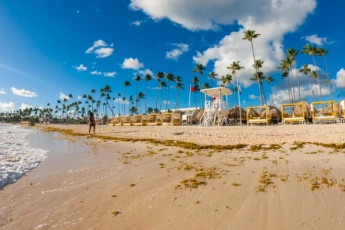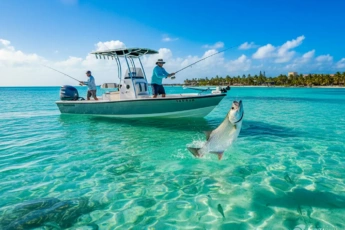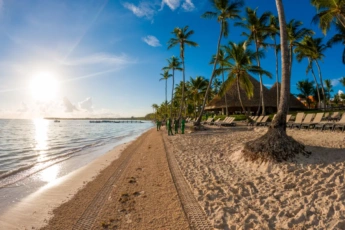Top 7 Dominican Republic Airports – All You Need to Know in 2026: Best Facilities, Transfers, Prices, Hotspots, Pros & Cons
The Dominican Republic has seven international airports, each with its unique features. Whether you want to relax on the famous beaches of Punta Cana, explore the historic city of Santo Domingo, or enjoy the peaceful beauty of Samaná, there’s an airport to get you there.
- Punta Cana International Airport (PUJ). PUJ is the busiest airport in the country, serving the popular tourist destination of Punta Cana. It is located on the island’s eastern tip, in Cabeza de Toro. So, if you’re staying in Cabeza de Toro, Bávaro, Punta Cana, Uvero Alto, or Cap Cana, PUJ is a convenient choice.
- Las Américas International Airport (SDQ). This airport is a major gateway to the country in Santo Domingo, the capital. Las Américas Airport is your go-to to explore the Colonial Zone, Boca Chica, or Juan Dolio. It’s also the main gateway if you’re headed to Barahona since you’ll be passing through Santo Domingo anyway.
- Cibao International Airport (STI) is in Santiago de los Caballeros, the second-largest city. It is the gateway to the northern region of the Dominican Republic and a great option if you’re headed to Santiago, Jarabacoa, or Constanza.
- Gregorio Luperón International Airport (POP). This small but convenient airport serves Puerto Plata and is close to many beautiful beaches and towns, making it a great starting point for your Dominican adventure. POP is a good choice if you stay in Puerto Plata city, Sosúa, Cabarete, Río San Juan, Punta Rucia, or Cabrera.
- La Romana International Airport (LRM) is a small airport focused on luxury tourism. It offers easy access to exclusive resorts and golf courses at Casa de Campo resort, La Romana, Bayahibe, and the beautiful Saona Island.
- La Isabela International Airport (JBQ). Smaller than the others, this airport is often used for private aviation and charter flights, mainly for Haiti and nearby islands like Cuba, St. Maarten, or Curaçao. 30 minutes drive to Santo Domingo.
- Samaná El Catey International Airport (AZS). This newer airport serves the Samaná Peninsula, known for its lush rainforests, waterfalls, and whale-watching opportunities.
These seven airports provide excellent connectivity to the Dominican Republic, ensuring a smooth arrival for travelers seeking sun, sand, and adventure. We will give an honest and in-depth look at all seven international airports in the Dominican Republic. We’ll delve into the facilities, services, transportation options, and overall experience for travelers at each location.
1. Punta Cana International
Airport (PUJ)
Punta Cana International Airport is the main gateway to the Dominican Republic’s renowned eastern coast. It handles over 7.6 million passengers annually and is a bustling hub connecting travelers to the country’s white-sand beaches and luxury resorts.
PUJ boasts two main terminals, Terminal A and Terminal B. Terminal A hosts many international airlines, including Air Canada, Lufthansa, and JetBlue. At the same time, Terminal B primarily serves American Airlines, British Airways, and Delta. Both terminals offer a range of amenities, including shops, restaurants, and seating areas.
- Many upscale resorts and gated communities are just a short drive away. Popular choices include Secrets Cap Cana, Hyatt Ziva Cap Cana, and Club Med Punta Cana, typically a 10-20 minute drive. For those seeking even more options, Hard Rock Hotel & Casino and Excellence Punta Cana are around 30-40 minutes away.
- Exclusive gated communities like Cap Cana, Punta Cana Resort & Club, and Tortuga Bay provide high-end homes, golf courses, and private beaches within 10-25 minutes of PUJ.
- A taxi ride from the airport to Bavaro Beach usually takes about 20-30 minutes and costs between $25 to $40, depending on the exact location and time of day.
Facilities and amenities
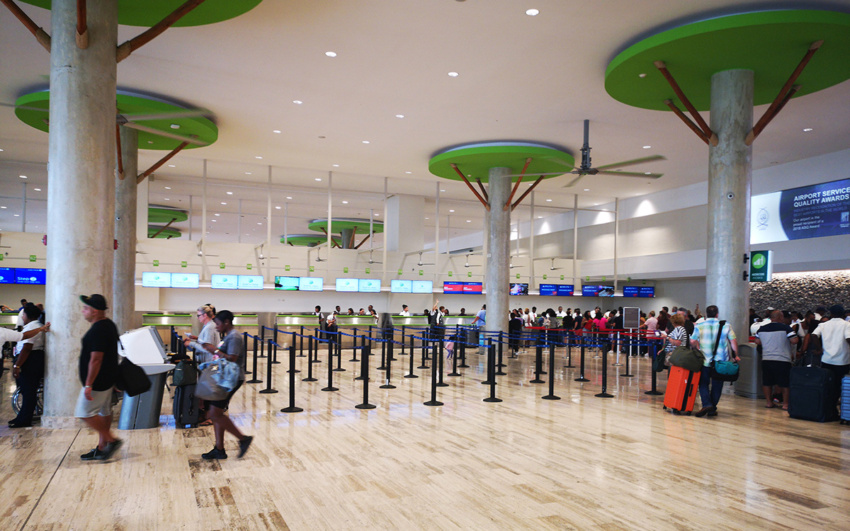
Punta Cana International Airport
- The airport provides various facilities to cater to passengers’ needs. Charging stations are conveniently located throughout the terminals, and nursing rooms are available for mothers. Dining options range from familiar brands like Wendy’s and Cinnabon to local specialties, offering something for every palate.
- For those seeking an elevated travel experience, PUJ offers VIP services that include expedited airport escorts, fast-track immigration and customs processing, and access to luxurious VIP lounges. These lounges feature comfortable seating, Wi-Fi, private restrooms, and even a swimming pool in Terminal B.
Private aviation
Punta Cana International Airport offers private aviation services through its Fixed Base Operations (FBO) terminal. Located on the airport grounds, the FBO caters to private planes, helicopters, and executive jets for both international and domestic flights.
The facility operates daily from 07:00 to 21:00, with additional staff available for off-hours operations. It provides services like aircraft handling, fueling, and passenger assistance. The airport also has a VIP terminal with exclusive amenities for those seeking extra luxury.
Accessibility and transportation
Punta Cana International Airport is committed to accessibility and assists travelers with disabilities. Car rentals, taxis, and shuttle services allow easy transportation to nearby destinations.
-

Mercedes s350 VIP Transfer in Punta Cana
from $126 View Details -
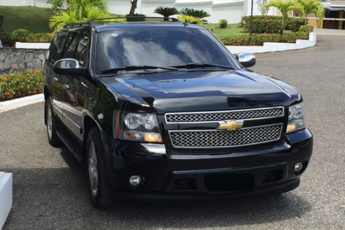
Chevrolet Suburban – VIP Transfer
from $97 View Details -

Limo – VIP Transfer
from $134 View Details -
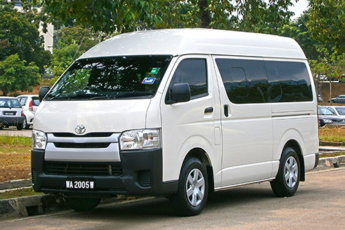
Passenger Car or Minibus Up to 4 People
from $42 View Details -

SUV or a Minivan (up to 6 People)
from $52 View Details -

Minibus Transportation Up To 8 People
from $62 View Details
Parking rates at Punta Cana International Airport:
- First 30 minutes or less: 50.00 DOP (around $0.88)
- First 24 hours: 750.00 DOP (roughly $13.25)
- Additional Days: 750.00 DOP (around $13.25 per day)
- If your ticket is lost: 1,000.00 DOP (around $17.67)
- Tire Lock: 1,000.00 DOP (roughly $17.67)
- Damage to the bars: 3,500.00 USD
Punta Cana airport duty free shops
- Punta Cana International Airport has duty-free shops in both terminals. In Terminal A, you’ll find popular shops like Duty-Free Americas, which carries a broad selection of spirits, tobacco, and cosmetics. For those interested in local products, the “Punta Cana Para Ti” stores feature locally made crafts, jewelry, and natural health products.
- Terminal B also hosts several prominent duty-free stores, including Victoria’s Secret, Hard Rock, and Tumi/Long-Champ/Swarovski, where travelers can purchase luxury goods and accessories. Additionally, both terminals offer convenience with various dining options, allowing you to grab a quick bite or enjoy a leisurely meal before your flight.
- Prices at these duty-free stores are presented in U.S. dollars for convenience, though most stores accept various currencies and credit cards. While international products may offer some tax savings, purchasing local products outside the airport is often recommended for better deals.
Pros & Cons of Punta Cana International Airport
Pros
- It’s easy to find your way around.
- Things are getting faster, like security checks.
- If you pay extra, you can get through the airport quickly.
- The airport is clean.
- There are lots of places to eat.
- The airport is air-conditioned and has places to sit.
Cons
- You often have to wait a long time.
- Airport workers can be pushy and want tips.
- Everything is expensive.
- Some airport workers aren’t very nice.
- It’s hard to find water to drink.
- The airport can be crowded and disorganized.
- Some people try to trick you or steal from you.
- The internet is slow and hard to use.
2. Las Américas International
Airport (SDQ)
Las Américas International Airport is a major airport near Santo Domingo, the Dominican Republic. It is a good starting point for exploring the country’s southern coast.
The airport opened in 1959 and has been modernized with new terminals and improved facilities. Today, it’s a hub for several airlines and sees a lot of international traffic. Even though it’s not the busiest airport in the country (Punta Cana holds that title), Las Américas is still a crucial gateway for travelers visiting the Dominican Republic.
- Boca Chica Beach: This famous beach is just a 10-15 minute drive from the airport, perfect for relaxing after a flight or before departure.
- Santo Domingo: The historic city center, a UNESCO World Heritage site, is about 30-40 minutes away by car. Explore its rich history and culture.
- Juan Dolio: For a quieter beach experience, head to Juan Dolio. It’s approximately 30-40 minutes by car from the airport.
Amenities and services
- Las Américas International Airport offers various services to make your travel experience comfortable. The terminal features free Wi-Fi, ATMs, places to exchange money, shops, and restaurants. The airport is also designed to be accessible to everyone, with features like special assistance lanes and accessible restrooms.
- If you’re looking for extra comfort and convenience, the airport has VIP lounges in both terminals. These lounges provide complimentary food and drinks, comfortable seating, and fast Wi-Fi. For an even more exclusive experience, you can book a private suite or enjoy expedited security screening.
Private aviation
Las Américas International Airport has dedicated facilities for private aviation. Services include hangar space, maintenance services, VIP ground handling, and expedited customs and immigration processes. Dedicated lounges for private jet passengers offer privacy and luxury.
Accessibility and transportation
Las Américas Airport is designed to be accessible to everyone. You’ll find ramps, unique bathrooms, and helpful staff for disabled passengers. Getting to the Colonial Zone from the airport is pretty easy. You can take a taxi, which usually costs about $30, to reach downtown Santo Domingo.
Rideshare services are another option. Several car rental companies are available at the airport if you prefer to drive. Many hotels also offer shuttle services for their guests.
Las Américas Airport parking options
- Short-term: It costs about $2.70 for the first two hours and then increases to $14.30 for the whole day.
- Long-term: Expect to pay around $14.30 for the first day and $3.60 for each extra day.
- Premium: This is the closest to the terminal but the most expensive. Prices range from $5.40 to $26.80 per day.
Duty-free shopping at Las Américas International Airport
Dufry is the main duty-free shop at Las Américas International Airport. They stock various items, from perfumes and makeup to liquor and cigarettes. While there might be other smaller shops, Dufry offers the biggest and most diverse selection. Here are some additional shops you might encounter:
- Cabinet Cigars: Perfect for cigar enthusiasts who want a taste of the Dominican Republic’s famous smokes.
- KB Store: This could be a smaller shop offering a variety of travel essentials or souvenirs.
- Manos Dominicanas: Here, you can find locally made crafts and souvenirs, a great way to take a piece of the Dominican Republic home with you.
Consider buying local products (like coffee, rum, or cigars) outside the airport. You might find better prices by exploring local shops or markets in the Dominican Republic.
Las Américas International Airport – pros & cons
Las Américas Airport has improved in recent years. It’s clean, modern, and has friendly staff. Getting through customs is easy, and there are many places to eat and shop.
However, there are still some problems. Things are expensive, especially food and drinks. It’s easy to get lost because the signs aren’t clear. Waiting in line takes a long time, and there aren’t enough places to sit. The bathrooms aren’t always clean, and the airport can be too hot.
3. Cibao International
Airport (STI)
Cibao International Airport is located in Santiago de los Caballeros, the second-largest city in the Dominican Republic, about 15 kilometers southeast of Santiago’s city center. It’s the third busiest airport in the Dominican Republic after Punta Cana and Las Americas International Airport.
The heart of Santiago is just a quick 20-minute drive. If you’re looking to explore the coast, Puerto Plata is about an hour away by car. It’s a 60-kilometer journey that offers a nice escape from the city. For those seeking a mountain getaway, Jarabacoa is a great choice. Situated roughly 40 kilometers from the airport, you can reach this charming town in about 45 minutes.
Keep in mind that taxi fares vary depending on your destination. A trip to Santiago City Center typically costs between $20 and $25. If you’re headed to Puerto Plata, be prepared to spend anywhere from $80 to $100. For Jarabacoa, expect to pay around $50 to $70 for a taxi ride.
Facilities and amenities
The airport is designed to be comfortable and convenient, with friendly staff ready to help. You can grab a bite to eat, shop at the duty-free stores, or get some work done in the business center. There’s free Wi-Fi everywhere in the airport, and you can find ATMs, places to exchange money, and even a drugstore.
The airport is currently being expanded and improved. They’re building a new terminal with better security, longer runways, and more comfortable passenger facilities. This project will be finished by 2026 and will help the airport handle more people as the local tourism and business industries grow
VIP services and private aviation
Cibao International Airport offers special services for travelers who want a more luxurious experience. This includes a private lounge with free snacks and drinks, faster security checks, priority boarding, and personal assistance. The lounge is a relaxing and exclusive space for passengers who prefer a premium travel experience.
The airport also caters to private jet owners and passengers. They offer services like airplane storage, fuel, and customs help. Private jet travelers can expect faster processing and personalized attention for a smooth journey.
Duty-free shops at the airport
The airport features several duty-free shops, including:
- Dufry Duty-Free: Offers a wide selection of perfumes, cosmetics, alcohol, tobacco, and luxury goods.
- La Aurora: Specializes in local cigars, particularly the renowned Dominican brands.
- Gift Shop: Sells a variety of local souvenirs, including coffee, chocolates, and crafts.
- Tech Store: Provides electronics and travel accessories for passengers needing last-minute tech essentials.
Dufry, a leading travel retailer, operates the shops. You can also shop online before your trip and collect your purchases at the airport.
Pros & cons of the Cibao International Airport
On the positive side, its compact size makes navigating the terminal simple. The clean facilities, from the sparkling bathrooms to the overall environment, create a pleasant atmosphere. The staff is friendly and professional, making interactions smooth and efficient. Moreover, the airport’s streamlined security and customs processes contribute to a swift journey through formalities.
However, long queues at check-in and security can be frustrating, especially during peak travel times. The mandated E-ticket process, which is poorly communicated and cumbersome, adds an extra layer of inconvenience to the boarding procedure. Finally, the chaotic traffic outside the airport, particularly during drop-offs and pickups, can be a daunting challenge for arriving and departing passengers.
4. Gregorio Luperón International
Airport (POP)
Gregorio Luperón International Airport (POP) is just a 20-minute drive from Puerto Plata city center. It is near attractions like the 27 Charcos waterfalls and the historic San Felipe Fortress. The airport connects travelers to cities across North America and Europe with easy access to major airlines like American Airlines, JetBlue, and Air Canada Rouge.
Popular spots near the airport
Gregorio Luperón International Airport is your starting point for exploring the Dominican Republic’s stunning north coast. Here are some popular spots nearby:
- Puerto Plata City Center: Just 11 miles away, this city offers a mix of history and modern life. You can explore colonial buildings, climb the San Felipe Fortress, or simply relax on the seaside promenade.
- Sosúa: This laid-back beach town is about 6 miles from the airport. Known for its beautiful beach, lively nightlife, and water sports, it’s a favorite among visitors.
- Cabarete: If you’re an adventure seeker, Cabarete is your place. Located around 12 miles away, it’s world-famous for windsurfing and kitesurfing.
- Playa Dorada: Looking to relax? This resort area is about 10 miles from the airport and offers beautiful beaches, golf courses, and all-inclusive resorts.
Taxis are easy to find at the airport and convenient to reach these spots. Here’s a general idea of what to expect:
- Puerto Plata City Center: About $35
- Sosúa: Around $25
- Cabarete: Expect to pay about $30
- Playa Dorada: Also around $30
Remember, these are estimates. Prices might change depending on the time of day or the taxi company. Having some Dominican pesos with you is helpful, even though many taxis accept US dollars.
Facilities & amenities
Gregorio Luperón Airport offers a mix of shops, restaurants, and services to keep you comfortable. You can grab a bite, shop, or relax in the VIP lounge. There’s parking available, and the airport is set up to help people with disabilities. You’ll also find ATMs, currency exchange, and information desks.
The airport has a VIP lounge with snacks, drinks, and Wi-Fi if you want extra comfort. Some airlines also offer faster check-in and security for VIP passengers. You might also get help with luggage or transportation.
Private aviation
Gregorio Luperón International Airport is equipped to handle private aviation, catering to business travelers, private jet owners, and VIPs who require privacy and exclusive services:
- Fixed Base Operator (FBO) Services: The airport has facilities that support private and corporate jets, including hangars, fueling services, and maintenance. The FBO services ensure that private flights receive the necessary support from when they land until they take off again.
- Customs and Immigration: Private aviation passengers can benefit from dedicated customs and immigration services, which allow faster processing and more privacy than commercial flights.
- VIP Handling: Private aviation companies operating out of POP often offer VIP handling services, including limousine transfers, in-flight catering, and concierge services to accommodate the specific needs of high-profile travelers.
Duty-free shops at Gregorio Luperón International Airport
The airport offers several shopping options. Duty-Free Americas is the main duty-free store, selling a wide range of products like alcohol, tobacco, cosmetics, and luxury items. You can also find shops for Dominican handicrafts, including cigars, rum, coffee, and other local products. Smaller gift shops offer travel essentials, magazines, books, snacks, and local souvenirs.
Pros and Cons of Gregorio Luperón International Airport (POP)
Pros:
- POP is generally clean and well-maintained, with quick customs and security processes.
- Airport staff are known for being helpful and welcoming, often speaking English.
- The airport offers a surprising variety of dining choices, including local cuisine.
- POP’s compact size makes it easy to find your way around and reduces stress.
- VIP lounge, live music upon arrival, and a positive atmosphere.
Cons:
- Food, drinks, and duty-free items are often overpriced.
- Some passengers have experienced scams, aggressive staff, and inconsistent service quality.
- Lack of water fountains and unreliable Wi-Fi are common complaints.
5. La Romana International
Airport (LRM)
La Romana International Airport is your entry point to the stunning southeastern coast of the Dominican Republic. Unlike most airports in the Dominican Republic, which are government-operated, La Romana International Airport is privately owned and managed by Central Romana Corporation, a major sugar producer in the region.
Known for its smaller, more intimate atmosphere than larger airports like Punta Cana, La Romana offers a relaxed and welcoming arrival experience.
What to expect
- Smaller and Quieter: Compared to busier airports, La Romana is small and has a single terminal building.
- Modern Facilities: Despite its size, the airport offers a high level of service, with VIP lounges and fast-track options, making it popular with private jets and high-end travelers.
- Proximity to Luxury Resorts: La Romana is particularly popular among travelers seeking upscale accommodations, as it’s located close to world-renowned resorts like Casa de Campo.
- Charter Flights: La Romana Airport is well-known for handling many charter flights. Many of these flights are booked by tour operators catering to tourists visiting all-inclusive resorts in the region.
- Duty-Free Shopping: Despite its small size, La Romana International Airport offers a few duty-free shops selling local products like rum, coffee, and cigars.
Pros & Cons of La Romana International Airport (LRM)
Pros
- La Romana Airport is small and simple to get around. It’s also conveniently located near popular resorts like Casa de Campo.
- The airport is always clean and well-kept, with enough amenities for passengers.
- There is a good selection of duty-free shops selling local products. The prices on some items, especially alcohol, are pretty reasonable.
- The airport staff is known for being helpful and friendly, which makes the whole experience more pleasant.
- There are cafes, fast food places, and even passenger smoking areas.
- Because the airport is small, you don’t need to take shuttle buses to get to your plane. This means you can board and get off quickly and easily.
Cons
- Passport control, customs, and security can take a long, especially when many people arrive at once. This is a common occurrence, particularly after big flights land.
- The airport can get crowded, and there aren’t enough places to sit, making it uncomfortable, especially during busy times.
- The Wi-Fi is slow.
- Checking in happens outside, which can be hot and uncomfortable, especially when busy.
- Security checks can be rigorous, requiring you to remove too much stuff, like shoes, belts, and even hats. Plus, your bags get checked carefully, which can be annoying.
- Airport staff aren’t very good at letting people know what’s happening, especially when there are problems or delays.
6. La Isabela International
Airport (JBQ)
La Isabela International Airport is located in the northern part of Santo Domingo, in the suburb of El Higüero. It was primarily built to handle domestic flights and relieve congestion at Las Américas International Airport (SDQ). It is closer to the city center than Las Américas International Airport.
The airport primarily serves domestic destinations such as Santiago de los Caballeros, Punta Cana, and other regional airports within the Dominican Republic. It also offers international flights to Caribbean destinations, including Aruba, Havana, and St. Maarten.
The airport also serves as a hub for general aviation, including private and charter flights, making it a popular choice for travelers seeking a more private and convenient travel experience.
Parking and taxi costs
If you plan to leave your car at the airport, it’ll cost you about $0.90 per hour you park. If you’ll be away for longer, long-term parking costs around $5.40 per day. Taking a taxi into the city? Expect to pay between $9 and $13, but remember that the price can change depending on traffic and the time of day. If you’re heading to Las Américas International Airport, a taxi ride costs you roughly $27 to $36.
La Isabela International Airport (JBQ) – Pros and Cons
Pros
- Convenient location: Close to Santo Domingo, making it easy to reach.
- Quick and easy: Smaller airport means faster processing times.
- Clean and well-maintained: Pleasant environment.
- Helpful staff: Friendly and accommodating employees.
- Basic amenities: Offers essential services like ATMs and food.
- Good for private planes: Suitable for small aircraft.
Cons
- Limited services: Fewer amenities compared to larger airports.
- Taxi scams: Overcharging tourists is reported.
- Customs issues: Some travelers report negative experiences.
- Language barrier: Limited English spoken by staff.
7. Samaná El Catey International
Airport (AZS)
Samaná El Catey International Airport, also known as Presidente Juan Bosch International Airport, is located near Sánchez and about a 45-minute drive from the popular tourist spot, Las Terrenas. This airport is perfect for travelers wanting to experience the famous Samaná region.
What to expect
- Modern Terminal: The airport has a modern terminal with all the basics: check-in, baggage claim, and customs.
- Seasonal Flights: Most flights to and from Samaná are during the tourist season, from December to April.
- Natural Beauty: You’re just a short drive away from amazing beaches, waterfalls, and lush rainforests.
Getting Around
- Taxi: You can quickly grab a cab outside the airport. Expect to pay around $70-80 to Las Terrenas.
- Car Rental: The airport has several car rental places. Prices start at about $35-50 per day.
- Shuttle: Some hotels offer airport shuttles. Check with your hotel for details.
Costs to Know
- Parking: Short-term parking costs about $2 an hour, and long-term parking costs around $12 a day.
- Airport Fees: There might be a departure tax of about $20 and a small security fee of around $10. These are usually included in your ticket price.
Pros and cons of Samaná El Catey International Airport (AZS)
Pros
- Quick and Easy: Getting through security and customs is usually fast and hassle-free.
- Friendly Staff: Airport employees are known for being helpful and welcoming.
- Cool and Comfortable: The airport is air-conditioned, a nice escape from the hot Dominican weather.
- Simple Layout: The airport is small and easy to navigate without getting lost.
Cons
- Limited Choices: There’s only one gate, shop, and restaurant, so your options are limited.
- Expensive Food and Shopping: The restaurant and duty-free shop prices are high.
- Inconsistent Cleanliness: Some areas of the airport can be dirty.
- Slow Wi-Fi: The free Wi-Fi is often slow and unreliable.
- Rough Security: Some passengers have had unpleasant experiences with security checks.
- Outdated Systems: The airport doesn’t accept electronic boarding passes.
- VIP Lounge Disappointment: The VIP lounge is small and overpriced for what it offers.
Frequently Asked Questions about
Airports in the DR
What is the busiest airport in the Dominican Republic?
Punta Cana International Airport (PUJ). It handles over 7.6 million passengers annually
Which airport serves the capital city, Santo Domingo?
Las Américas International Airport (SDQ). Visiting Colonial Zone, Boca Chica, Juan Dolio, and Barahona is very comfortable from this spot.
Which airport is closest to Puerto Plata and its beaches?
Gregorio Luperón International Airport (POP).
What is the 3-letter airport code for the Dominican Republic?
The Dominican Republic has no single 3-letter airport code for the entire country. Instead, each major airport has its specific code. Here are some of the main 3-letter codes for key airports in the Dominican Republic:
- PUJ: Punta Cana International Airport
- SDQ: Las Américas International Airport (serving Santo Domingo)
- POP: Gregorio Luperón International Airport (serving Puerto Plata)
- STI: Cibao International Airport (serving Santiago)
- LRM: La Romana International Airport
- AZS: Samaná El Catey International Airport
Is it safe to travel to the Dominican Republic today?
The Dominican Republic is a popular tourist destination with many areas considered safe.
Which airport is better in the Dominican Republic?
It depends on your destination and needs; PUJ is popular for Punta Cana, while SDQ serves Santo Domingo.
Which country is SDQ airport?
The Dominican Republic.
How far is PUJ from POP?
About 280 kilometers (175 miles).
Which airport is PUJ?
Punta Cana International Airport.
Is Santo Domingo airport big?
Yes, Las Américas International Airport (SDQ) is the largest in the country.
What does SDQ mean in the airport?
It is the code for Las Américas International Airport in Santo Domingo.
Who owns Dominican airport?
In the Dominican Republic, most major airports are operated by government entities. However, Punta Cana International Airport (PUJ) is privately owned and operated by the Punta Cana Group. This airport stands out as one of the largest and busiest in the country, and its private ownership allows for more direct control over its operations and services.
Other major airports, like Las Américas International Airport (SDQ) and Cibao International Airport (STI), are managed by governmental or semi-governmental entities.
Which side of the Dominican Republic is better?
Both the eastern (Punta Cana) and northern (Puerto Plata) sides offer unique attractions; it depends on personal preferences.
Is the Dominican Republic a good destination?
Yes, it is known for its beautiful beaches, resorts, and diverse attractions.
Updated on: . Author:

